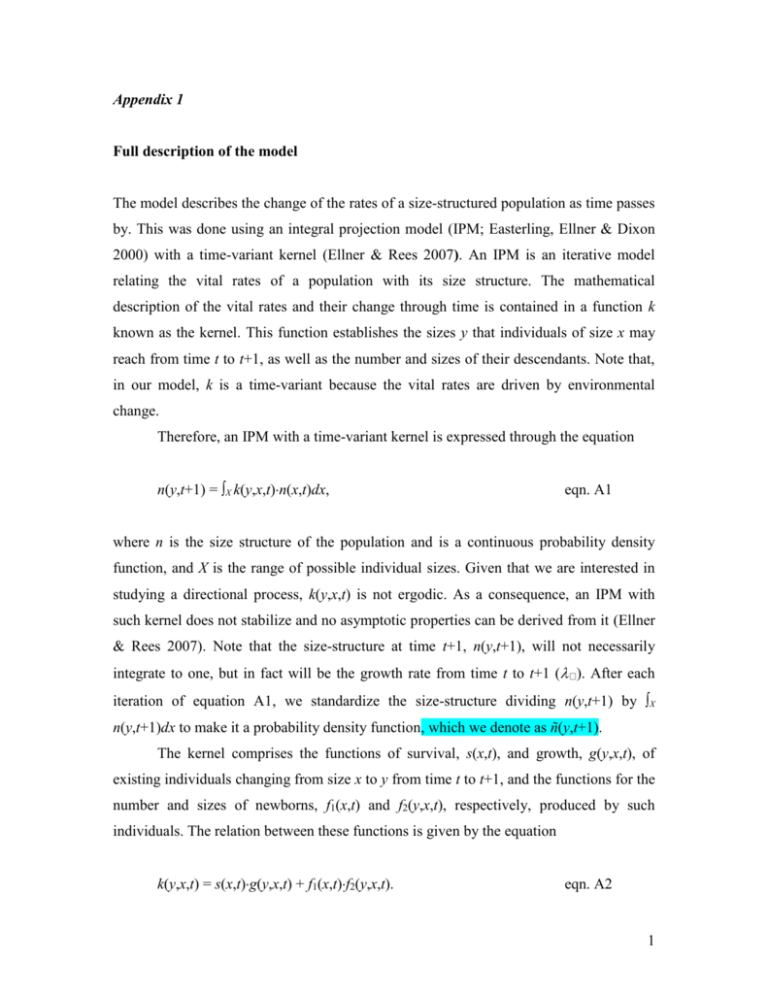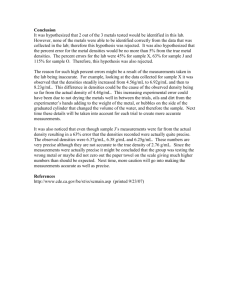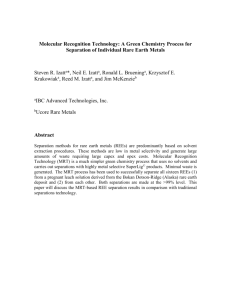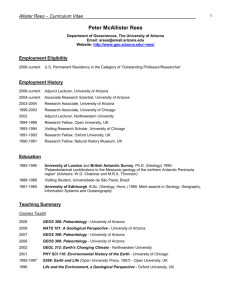Appendix 1 Full description of the model The model describes the
advertisement

Appendix 1
Full description of the model
The model describes the change of the rates of a size-structured population as time passes
by. This was done using an integral projection model (IPM; Easterling, Ellner & Dixon
2000) with a time-variant kernel (Ellner & Rees 2007). An IPM is an iterative model
relating the vital rates of a population with its size structure. The mathematical
description of the vital rates and their change through time is contained in a function k
known as the kernel. This function establishes the sizes y that individuals of size x may
reach from time t to t+1, as well as the number and sizes of their descendants. Note that,
in our model, k is a time-variant because the vital rates are driven by environmental
change.
Therefore, an IPM with a time-variant kernel is expressed through the equation
n(y,t+1) = X k(y,x,t)n(x,t)dx,
eqn. A1
where n is the size structure of the population and is a continuous probability density
function, and X is the range of possible individual sizes. Given that we are interested in
studying a directional process, k(y,x,t) is not ergodic. As a consequence, an IPM with
such kernel does not stabilize and no asymptotic properties can be derived from it (Ellner
& Rees 2007). Note that the size-structure at time t+1, n(y,t+1), will not necessarily
integrate to one, but in fact will be the growth rate from time t to t+1 ( ). After each
iteration of equation A1, we standardize the size-structure dividing n(y,t+1) by X
n(y,t+1)dx to make it a probability density function, which we denote as ñ(y,t+1).
The kernel comprises the functions of survival, s(x,t), and growth, g(y,x,t), of
existing individuals changing from size x to y from time t to t+1, and the functions for the
number and sizes of newborns, f1(x,t) and f2(y,x,t), respectively, produced by such
individuals. The relation between these functions is given by the equation
k(y,x,t) = s(x,t)g(y,x,t) + f1(x,t)f2(y,x,t).
eqn. A2
1
We assumed that the size of the parent does not influence the size of its newborn, i.e.
f2(y,x,t) = f2(y,t), as this effect is relatively small in the case of many species (Michaels et
al. 1988). For species with asexual propagation this may not be the case (Méndez &
Obeso 1993; Nicholls 2011), but the model can be modified accordingly.
The above functions (s, g, f1 and f2) are usually determined via generalized linear
or additive models fitted to observed demographic data (Ellner & Rees 2006; Garcia,
Dahlgren & Ehrlén 2011). As the identity of such models is not expected to exert great
influence over the reconstructed vital rates (González, Rees & Martorell 2012), we used
the following simple functions to determine the vital rates with 16 parameters:
Survival:
logit(s(x,t)) = 1 + 2x + 3t + 4xt
Growth:
g(y,x,t) = normal(y; = 5 + 6x + 7t + 8xt, 2 = 9)
Fecundity:
log(f1(x,t)) = 10 + 11x + 12t + 13xt
eqns. A3
Seedling size: f2(y,t) = normal(y; = 14 + 15t, 2 = 16)
These functions have been previously used when modeling plant demography using IPMs
(Easterling, Ellner & Dixon 2000; Metcalf, Rose & Rees 2003).
To assess the capability of any given set of 16 parameter values to reproduce the
observed time series we developed a composite likelihood function. Let us first define the
notation associated with the observed data that we will use hereafter: M is the number of
times the population was sampled, T1,T2,…,TM the times (not necessarily consecutive) at
which the populations were sampled, N1,N2,…,NM the number of individuals sampled
each time, Xi = {Xi1, Xi2, …, XiNi} the set of sizes of all the individuals sampled at time i,
and Di the observed population density at time i, i = 1,…,M. Note that we are using
capital letters to distinguish the observed data from the functions associated with the
model.
For a given set of 16 parameter values, we first obtained the vital rates for each
point in time (e.g. year) from T1 to TM. This was done by substituting the parameter
values in equations A3, assembling the kernel (equation A2) and evaluating this function
at times t = T1,T1+1,…,TM. Such evaluations resulted in the vital rates at each point in
2
time. We then calculated the time series of size structures through the iteration of
equation A1. To do so, the initial size structure, n(x,T1), is required. If no environmental
change had occurred before the initial observed time (i.e., if the environment had
remained constant), it would be safe to assume that the population was in its stable state
(Caswell 2001). Therefore, in the first iteration of equation A1 we used the stable sizestructure associated with the vital rates kernel at the initial time; i.e. n(x,T1) is the
asymptotic size-structure associated with k(y,x,T1). In case such assumption would not
hold (Yearsley 2004), other functions could be used as the initial size structure, such as
the one associated with X1. Therefore, through the iteration of equation A1, we obtain a
series
of
(reconstructed)
size
structures
spanning
from
T1
to
TM:
ñ(x,T1),ñ(x,T1+1),…,ñ(x,TM). As we were interested in comparing the reconstructed sizestructures with the observed data, we retained only those associated with the times of
sampling, i.e. we retained ñ(x,T1),ñ(x,T2),…,ñ(x,TM).
The reconstructed population densities resulted from multiplying the growth rates
obtained at each iteration by the initial observed density; i.e., for a particular time t >T1,
the modeled density
d(t) = ssD1,
eqn. A4
where s = T1,T1+1,...,t and s = X n(x,s)dx.
The composite log-likelihood function we developed combined two loglikelihoods: one comparing the fit of the reconstructed size structures to the observed
individual’s sizes and one comparing the fit of the reconstructed densities to the observed
ones. The first is defined as the natural logarithm of the probability of observing the
sizes of the individuals at the different sampling times given the particular values of the
parameters. Such probability is calculated using the probability distributions retained
above: ñ(x,T1),ñ(x,T2),…,ñ(x,TM). Mathematically, this is defined as:
ln(1, 2, …, 16) = ln(Pr(X1, …, XM1, 2, …, 16))
= i j ln(ñ(Xij,Ti)),
eqn. A5
3
where 1, 2, …, 16 are the 16 particular values of the parameters, and Xij is the size of
the j-th observed individual at the i-th sampling point in time.
For the log-likelihood associated with the population densities we did not have a
probability distribution associated with each reconstructed density. Therefore, we
assumed that d(t) had a lognormal distribution (denoted lnN). We chose this distribution
as density is a positive continuous variable and it would be a reasonable expectation to
have ln(d(t)) normally distributed (Engen & Lande 1996). Again, we define the loglikelihood associated to the fit of the reconstructed densities to the observed ones as the
natural logarithm of the probability of observing such densities at the different sampling
times given the particular values of the parameters. Such probability is calculated using
the lognormal distribution. Mathematically, this is defined as:
ld(1, 2, …, 16) = ln(Pr(D1, D2, …, DM1, 2, …, 16))
= i ln(lnNi(d(Ti))),
eqn. A6
where lnNi is the lognormal distribution associated with d(Ti).
Finally, we combined the two log-likelihood functions (equations A5 & A6) into
the composite function:
l(p1, p2, …, p16) = ln(1, 2, …, 16) + wld(1, 2, …, 16),
eqn. A7
where w is a weighting factor of the relative importance on the estimation of the
parameters of fitting the observed size-structures vs. fitting the observed population
densities. This term was introduced because at each point in time (Ti) there is only one
datum for density (Di), but several for size structure ({Xi1, Xi2, …, XiNi}), and not using a
weight would make density to have a minor contribution to l. The right value for w can be
determined experimentally.
The values of the parameters that maximize equation A7 determine a kernel
representing size-structured vital rates and their change through time that best fits the
observed size structures and densities.
4
Model assumptions
The main assumption that the model relies on is that, as size-structured vital rates change
directionally through time due to a long-term environmental process affecting them, the
size structure and density that derive from them change accordingly.
This general assumption can be decomposed into particular easier-to-verify ones. These
assumptions can be mandatory or optional. In this latter case, the work needed to change
it is indicated in parenthesis.
1. The species recovery time is larger than the recurrence of the environmental
process (mandatory).
2. A continuous variable, in our case size, structures the population (mandatory, but
cf. Gross et al. 2006).
3. The environmental process is chronic and changes through time, be it in intensity
or cumulative effect on the population (mandatory).
4. The form of the relation between time and the environmental process is known
(linear in our case, but easy to change).
5. The time elapsed between population’s measurements is known without error
(mandatory).
6. The form of the relationship between size and each demographic process is
known (linear in our case, but easy to change).
7. The form of the relationship between time and each demographic process is
known (linear in our case, but easy to change).
Two assumptions relate to the type of data required to use the model:
1. Sample sizes are sufficiently large for the data to contain the information on the
effect of the environmental process on the size structure and density (mandatory).
2. Populations are randomly sampled (mandatory).
5
Another two relate to our decision to use IPMs:
1. Density-independence (easy to change).
2. Deterministic (easy to change will increase complexity and probably reduce
confidence on the results, see Ellner & Rees 2007, Ghosh, Gelfand & Clark
2012).
Finally, additional assumptions are particular to the study system used to validate the
model with real data:
1. Homogeneity of the environment among sites (violation reduces confidence on
the results and other directional factors should be discarded as explanatory
variables of the difference between size structures and densities in the different
populations).
2. The intensity of the environmental process differs between populations
(mandatory).
3. The relationship between chronic anthropogenic disturbance and time is known
(linear in our case, but easy to change).
4. Seedling size is parent-size independent (easy to change).
5. Seedling establishment is proportional to flower production (easy to change).
6. The first observed population is in its stable state (easy to change).
References
Caswell, H. (2001) Matrix Population Models: construction, analysis, and interpretation.
Sinauer Associates, Sunderland, MA.
Easterling, M.R., Ellner, S.P. & Dixon, P.M. (2000) Size-specific sensitivity: applying a
new structured population model. Ecology, 81, 694-708.
Ellner, S.P. & Rees, M. (2006) Integral projection models for species with complex
demography. The American Naturalist, 167, 410-428.
Ellner, S.P. & Rees, M. (2007) Stochastic stable population growth in integral projection
models: theory and application. Journal of Mathematical Biology, 54, 227-256.
6
Engen, S. & Lande, R. (1996) Population dynamic models generating the lognormal
species abundance distribution. Mathematical biosciences, 132, 169-183.
Garcia, M.B., Dahlgren, J.P. & Ehrlén, J. (2011) No evidence of senescence in a 300year-old mountain herb. Journal of Ecology, 991, 1424-1430.
Ghosh, S., Gelfand, A.E. & Clark, J.S. (2012) Inference for size demography from point
pattern data using integral projection models. Journal of Agricultural, Biological,
and Environmental Statistics, 17, 641-677.
González, E.J., Rees, M. & Martorell, C. (2012) Identifying the demographic processes
relevant for species conservation in human-impacted areas: does the model
matter? Oecologia.
Gross, K., Morris, W.F., Wolosin, M.S. & Doak, D.F. (2006) Modeling vital rates
improves estimation of population projection matrices. Population Ecology, 48,
79-89.
Méndez, M. & Obeso, J.R. (1993) Size-dependent reproductive and vegetative allocation
in Arum italicum (Araceae). Canadian Journal of Botany, 71, 309-314.
Metcalf, J.C., Rose, K.E. & Rees, M. (2003) Evolutionary demography of monocarpic
perennials. Trends in Ecology & Evolution, 18, 471-480.
Michaels, H.J., Benner, B., Hartgerink, A.P., Lee, T.D., Rice, S., Willson, M.F. & Bertin,
R.I. (1988) Seed size variation: magnitude, distribution, and ecological correlates.
Evolutionary Ecology, 2, 157-166.
Nicholls, A.M. (2011) Influences of environmental variability, genetics and plant size on
variation in sexual and clonal reproduction and allocation of resources in three
wetland plant species. PhD, Cleveland State University.
Yearsley, J.M. (2004) Transient population dynamics and short-term sensitivity analysis
of matrix population models. Ecological Modelling, 177, 245-258.
7







